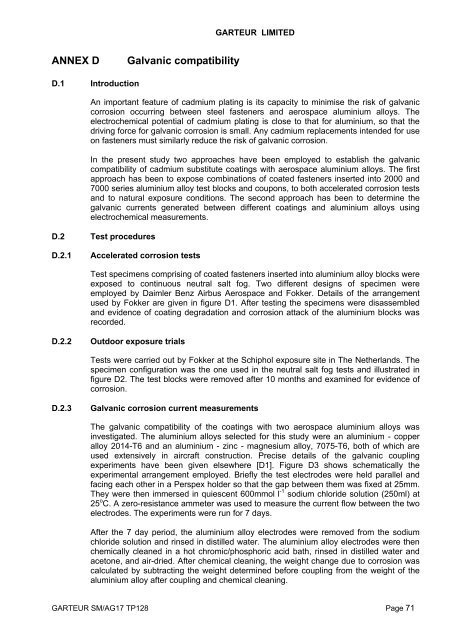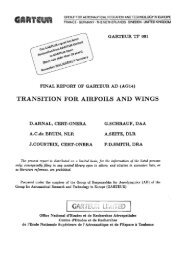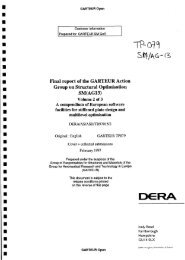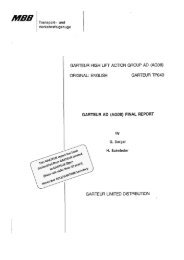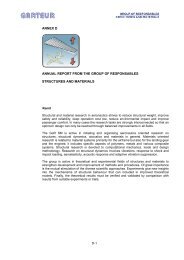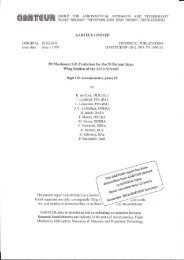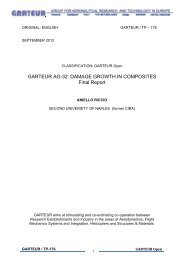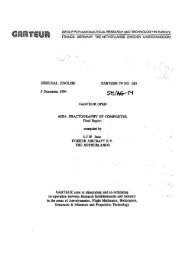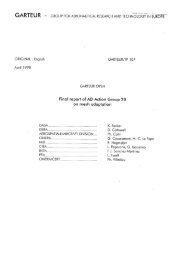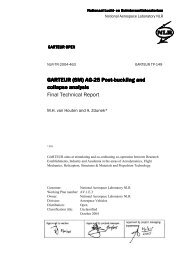Cadmium Substitution - garteur
Cadmium Substitution - garteur
Cadmium Substitution - garteur
Create successful ePaper yourself
Turn your PDF publications into a flip-book with our unique Google optimized e-Paper software.
GARTEUR LIMITED<br />
ANNEX D<br />
Galvanic compatibility<br />
D.1 Introduction<br />
An important feature of cadmium plating is its capacity to minimise the risk of galvanic<br />
corrosion occurring between steel fasteners and aerospace aluminium alloys. The<br />
electrochemical potential of cadmium plating is close to that for aluminium, so that the<br />
driving force for galvanic corrosion is small. Any cadmium replacements intended for use<br />
on fasteners must similarly reduce the risk of galvanic corrosion.<br />
In the present study two approaches have been employed to establish the galvanic<br />
compatibility of cadmium substitute coatings with aerospace aluminium alloys. The first<br />
approach has been to expose combinations of coated fasteners inserted into 2000 and<br />
7000 series aluminium alloy test blocks and coupons, to both accelerated corrosion tests<br />
and to natural exposure conditions. The second approach has been to determine the<br />
galvanic currents generated between different coatings and aluminium alloys using<br />
electrochemical measurements.<br />
D.2 Test procedures<br />
D.2.1<br />
Accelerated corrosion tests<br />
Test specimens comprising of coated fasteners inserted into aluminium alloy blocks were<br />
exposed to continuous neutral salt fog. Two different designs of specimen were<br />
employed by Daimler Benz Airbus Aerospace and Fokker. Details of the arrangement<br />
used by Fokker are given in figure D1. After testing the specimens were disassembled<br />
and evidence of coating degradation and corrosion attack of the aluminium blocks was<br />
recorded.<br />
D.2.2<br />
Outdoor exposure trials<br />
Tests were carried out by Fokker at the Schiphol exposure site in The Netherlands. The<br />
specimen configuration was the one used in the neutral salt fog tests and illustrated in<br />
figure D2. The test blocks were removed after 10 months and examined for evidence of<br />
corrosion.<br />
D.2.3<br />
Galvanic corrosion current measurements<br />
The galvanic compatibility of the coatings with two aerospace aluminium alloys was<br />
investigated. The aluminium alloys selected for this study were an aluminium - copper<br />
alloy 2014-T6 and an aluminium - zinc - magnesium alloy, 7075-T6, both of which are<br />
used extensively in aircraft construction. Precise details of the galvanic coupling<br />
experiments have been given elsewhere [D1]. Figure D3 shows schematically the<br />
experimental arrangement employed. Briefly the test electrodes were held parallel and<br />
facing each other in a Perspex holder so that the gap between them was fixed at 25mm.<br />
They were then immersed in quiescent 600mmol l -1 sodium chloride solution (250ml) at<br />
25 o C. A zero-resistance ammeter was used to measure the current flow between the two<br />
electrodes. The experiments were run for 7 days.<br />
After the 7 day period, the aluminium alloy electrodes were removed from the sodium<br />
chloride solution and rinsed in distilled water. The aluminium alloy electrodes were then<br />
chemically cleaned in a hot chromic/phosphoric acid bath, rinsed in distilled water and<br />
acetone, and air-dried. After chemical cleaning, the weight change due to corrosion was<br />
calculated by subtracting the weight determined before coupling from the weight of the<br />
aluminium alloy after coupling and chemical cleaning.<br />
GARTEUR SM/AG17 TP128 Page 71


